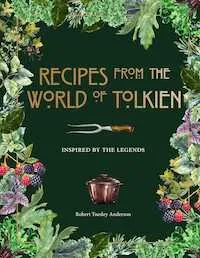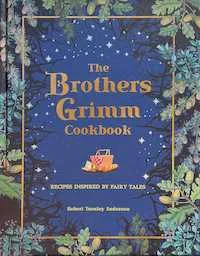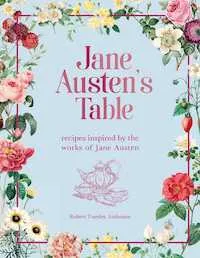
A Dive into Pop Culture Cookbooks
It’s a good time for cooks in fandoms. Every day, we’re seeing more and more pop culture cookbooks that combine cooking and baking with a franchise. There have been cookbooks dedicated to Disney Villians, Golden Girls, Alice in Wonderland, Star Wars, Friends, and so many more. Honestly, it seems if there is a fandom, there’s a cookbook that goes along with it, whether it’s official or unofficial. And yes, I just stopped writing this article to check and see if Jurassic Park and Indiana Jones had cookbooks. They do.
Since we are in the month of the Great Feast, I thought it would be fascinating to explore how writers create these pop culture cookbooks. I talked with two authors, Robert Tuesley Anderson and Olivia Luna Eldritch. Anderson wrote Recipes from the World of Tolkien, Jane Austen’s Table, The Elven Cookbook: Recipes Inspired by the Elves of Tolkien, and the Brothers Grimm Cookbook. Eldritch is the author of Recipes from the World of H. P. Lovecraft. Each book interweaves the life and works of the author with recipes.
Combining Food and Literature

So why combine the world of food with the world of literature? For Eldritch, it meant turning a solitary activity of reading into a shared one. She said, “There’s a great joy to be had in celebrating our love of literature with food, something that is usually shared. I love the idea that people might cook these recipes and enjoy them together while discussing the stories that inspired them, and I think it can also help people to rediscover favourite tales and characters and see them in a new light.”
Anderson pointed to the sensuousness of both food and literature: “Good writing is a sensuous, sensual experience — it sharpens our experience of the thinginess of the world, the things we look at, hear, touch…and taste. So there’s a natural marriage there — ingredients and words.”
Making the Recipes

Some works of literature were a bit easier to come up with recipes for than others. “Tolkien is full of feasts and hungry Hobbits (the wonderful unexpected tea party that starts The Hobbit),” Anderson said, “Austen interweaves food into her heroines’ daily lives as well as into her letters.” But The Brothers Grimm is notable for the opposite, he explained, noting the “the starving woodsman family in ‘Hansel and Gretel.’”
The works of H.P. Lovecraft presented their own challenges. Eldritch noted, “There’s often a certain squeamishness on the occasions when food does appear in his stories — like Olmstead’s reluctance to eat anything except tinned soup in Innsmouth, or the way the fruit in the orchard turns foul in ‘The Colour Out of Space.'”
Staying True to the Books

Translating recipes is one thing, but how do the authors balance making actual recipes that retain the spirit of the book? Of course, it depended on the source material. Both authors relished the challenge. Anderson said, “You have to imagine recipes that relate in some way. Sometimes, I confess, it’s pretty tenuous, but I try to make it fun. (Sometimes the fun is the tenuousness.)”
Anderson found Austen fairly straightforward since it required some historical research and updating of some recipes. For The Brothers Grimm, he used a lot of basic ingredients like milk, flour, and potatoes that were “the staples of European ‘peasant’ cookery.” But Tolkien was more of a challenge “that well-known problem (present in the books) of using New World ingredients like tomatoes, avocados, potatoes (potatoes appear quite a lot in LoTR),” he said.
Eldritch loved the challenge, especially when creating recipes for abstract concepts. For instance, she loved coming up with “the violet truffles inspired by the purple glow of Keziah’s ‘witch light’ from ‘The Dreams in the Witch House,’” she explained.
Plus, she enjoyed playing with the food with some of the more “queasy moments.” Eldritch said, I also enjoyed including some recipes that reflected Lovecraft’s own life as well as his fiction. He was a very frugal and somewhat fussy eater, and it was fun finding ways to reflect his preferred foods in the recipes. I particularly enjoyed the fact that he once described his wife Sonia’s bran muffins as ‘edible’ — clearly the height of culinary excellence in his eyes.”
But she didn’t want to make the cookbook scary. “It was about celebrating Lovecraft’s work and the position his creations hold in the popular imagination,” Eldritch said.
However, in addition to his contributions to horror, Lovecraft has a legacy of racism in his work. When asked how Eldritch tackled this difficult topic, she wrote: “Lovecraft was a very fearful man, and this is clear in much of his writing, with his protagonists often deeply terrified by the unknown. It is an unfortunate but undeniable fact that this attitude manifested itself in his everyday life as overt racism, and the views he expressed in some of his writings and letters are reprehensible to modern readers — and no doubt would have been to many of his contemporaries also.”
She continued, “As times change and we (hopefully) become more educated and thoughtful, it is down to the individual reader to decide to what extent (if at all) they are able to appreciate aspects of the art while simultaneously disagreeing with the views of the artist. I will admit there was not much scope to explore this difficult subject in this cookbook, but it’s an important question and one that a lot of academics and writers have tackled much more skillfully than I could hope to.”
Notable Recipes from the Books

When creating the books, the authors had some adventures with certain recipes. Eldritch noted that Lovecraft abstained from alcohol, but since there were many potions and drinks in his works, she decided to include cocktails. But her editor thought there was too much, so she adjusted the recipes, including an alcohol-free drink named Gibbous Moon lemonade, one of his favorite adjectives, Eldritch said.
When she told people she was making the book, people assumed that she was going to do a squid dish for Cthulhu. Yes, that’s an obvious choice, she noted. But she particularly was fond of a recipe inspired by his lesser-known stories “In the Vault.” She said, “It’s about a crooked undertaker getting trapped in a vault with a stack of coffins full of mouldering corpses. Weird Tales even rejected the story for being too gruesome. I was racking my brains trying to think of a way to work it into a recipe pairing, and then I remembered the existence of coffin bread. I was pretty happy with that.”
When dealing with food and Tolkien, the first thought is Lembas bread, highlighted as the food that Frodo and Sam have on the last trek of their journey to Mordor. But Anderson noted that there were many problems making it. He concluded: “We were never going to match the fictional reality (made from corn first sown by one of Tolkien’s ‘goddesses,’ Yavanna) — like trying to find a recipe for ambrosia — so perhaps we shouldn’t have attempted!”
Instructions on How to Use Cookbooks
So, how do the authors envision people using their works? Eldritch reiterated, “Ideally, I would love for people to read the stories associated with the recipes so that they can enjoy both together. For some of the shorter stories, you could even gather a group together and have a reading of the story before enjoying the meal.”
Anderson noted that they can be fun to read on their own. He sometimes reads cookbooks for the escapist value, not just for recipes. Some others may want to make the recipes. He hopes people do both. He did note, “One thing: I know some people are using the Tolkien cookbooks to organize Tolkien-themed evenings, costumes and all, and that’s wonderful and an honour!”
So, if you want to make your next feast with extra flair, consider making the holiday a nod to Jane Austen, the Brothers Grimm, or Tolkien.
If you are looking for more pop culture cookbooks, check out Gino Garcia’s Coco: The Official Cookbook; Jenny Dorsey’s Avatar: The Last Airbender: The Official Cookbook: Recipes from the Four Nations; and Jenn Fujikawa and Marc Sumerak’s Star Wars: The Ultimate Cookbook: The Official Guide to Cooking Your Way Through the Galaxy.
Want more cookbooks? Here’s a list of more pop culture cookbooks from 2018 and another on horror baking books from 2020!


